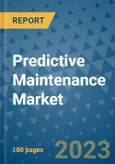1. Executive Summary
1.1. Global Predictive Maintenance Market: Snapshot
1.2. Future Projections, 2023 - 2030, (US$ Mn)
1.3. Key Segment Analysis and Competitive Insights
1.4. Premium Insights
2. Market Overview
2.1. Market Definitions and Segmentation
2.2. Market Dynamics
2.2.1. Driver
2.2.2. Restraint
2.2.3. Industry Challenges & Opportunities
2.3. Market Forces Analysis
2.3.1. Value Chain Analysis
2.3.2. Porters Five Forces Analysis
2.4. Challenges and Solutions
2.5. Supply Chain Impact Analysis
2.6. COVID-19 Impact Analysis
2.6.1. Pre and Post Covid-19 Analysis
2.7. Regulatory Scenario
2.8. Economic Analysis
3. Global Predictive Maintenance Market Outlook, 2018 - 2030
3.1. Global Predictive Maintenance Market Outlook, by Deployment, Value (US$ Mn), 2018 - 2030
3.1.1. Key Highlights
3.1.1.1. Cloud
3.1.1.2. On-premises
3.1.2. Market Attractiveness Analysis
3.2. Global Predictive Maintenance Market Outlook, by Solutions, Value (US$ Mn), 2018 - 2030
3.2.1. Key Highlights
3.2.1.1. Integrated
3.2.1.2. Standalone
3.2.2. Market Attractiveness Analysis
3.3. Global Predictive Maintenance Market Outlook, by Application, Value (US$ Mn), 2018 - 2030
3.3.1. Key Highlights
3.3.1.1. Manufacturing
3.3.1.2. Transportation
3.3.1.3. Energy & Power Generation
3.3.1.4. Oil & Gas
3.3.1.5. IT & Telecommunication
3.3.1.6. Misc. (Defense, etc.)
3.3.2. Market Attractiveness Analysis
3.4. Global Predictive Maintenance Market Outlook, by Region, Value (US$ Mn), 2018 - 2030
3.4.1. Key Highlights
3.4.1.1. North America
3.4.1.2. Europe
3.4.1.3. Asia Pacific
3.4.1.4. Latin America
3.4.1.5. Middle East & Africa
3.4.2. Market Attractiveness Analysis
4. North America Predictive Maintenance Market Outlook, 2018 - 2030
4.1. North America Predictive Maintenance Market Outlook, by Deployment, Value (US$ Mn), 2018 - 2030
4.1.1. Key Highlights
4.1.1.1. Cloud
4.1.1.2. On-premises
4.2. North America Predictive Maintenance Market Outlook, by Solutions, Value (US$ Mn), 2018 - 2030
4.2.1. Key Highlights
4.2.1.1. Integrated
4.2.1.2. Standalone
4.3. North America Predictive Maintenance Market Outlook, by Application, Value (US$ Mn), 2018 - 2030
4.3.1. Key Highlights
4.3.1.1. Manufacturing
4.3.1.2. Transportation
4.3.1.3. Energy & Power Generation
4.3.1.4. Oil & Gas
4.3.1.5. IT & Telecommunication
4.3.1.6. Misc. (Defense, etc.)
4.4. North America Predictive Maintenance Market Outlook, by Country, Value (US$ Mn), 2018 - 2030
4.4.1. Key Highlights
4.4.1.1. U.S.
4.4.1.2. Canada
5. Europe Predictive Maintenance Market Outlook, 2018 - 2030
5.1. Europe Predictive Maintenance Market Outlook, by Deployment, Value (US$ Mn), 2018 - 2030
5.1.1. Key Highlights
5.1.1.1. Cloud
5.1.1.2. On-premises
5.2. Europe Predictive Maintenance Market Outlook, by Solutions, Value (US$ Mn), 2018 - 2030
5.2.1. Key Highlights
5.2.1.1. Integrated
5.2.1.2. Standalone
5.3. Europe Predictive Maintenance Market Outlook, by Application, Value (US$ Mn), 2018 - 2030
5.3.1. Key Highlights
5.3.1.1. Manufacturing
5.3.1.2. Transportation
5.3.1.3. Energy & Power Generation
5.3.1.4. Oil & Gas
5.3.1.5. IT & Telecommunication
5.3.1.6. Misc. (Defense, etc.)
5.4. Europe Predictive Maintenance Market Outlook, by Country, Value (US$ Mn), 2018 - 2030
5.4.1. Key Highlights
5.4.1.1. Germany
5.4.1.2. France
5.4.1.3. U.K.
5.4.1.4. Norway
5.4.1.5. Turkey
5.4.1.6. Russia
5.4.1.7. Rest of Europe
5.4.2. BPS Analysis/Market Attractiveness Analysis
6. Asia Pacific Predictive Maintenance Market Outlook, 2018 - 2030
6.1. Asia Pacific Predictive Maintenance Market Outlook, by Deployment, Value (US$ Mn), 2018 - 2030
6.1.1. Key Highlights
6.1.1.1. Cloud
6.1.1.2. On-premises
6.2. Asia Pacific Predictive Maintenance Market Outlook, by Solutions, Value (US$ Mn), 2018 - 2030
6.2.1. Key Highlights
6.2.1.1. Integrated
6.2.1.2. Standalone
6.3. Asia Pacific Predictive Maintenance Market Outlook, by Application, Value (US$ Mn), 2018 - 2030
6.3.1. Key Highlights
6.3.1.1. Manufacturing
6.3.1.2. Transportation
6.3.1.3. Energy & Power Generation
6.3.1.4. Oil & Gas
6.3.1.5. IT & Telecommunication
6.3.1.6. Misc. (Defense, etc.)
6.4. Asia Pacific Predictive Maintenance Market Outlook, by Country, Value (US$ Mn), 2018 - 2030
6.4.1. Key Highlights
6.4.1.1. China
6.4.1.2. India
6.4.1.3. Singapore
6.4.1.4. Malaysia
6.4.1.5. Australia
6.4.1.6. Rest of Asia Pacific
6.4.2. BPS Analysis/Market Attractiveness Analysis
7. Latin America Predictive Maintenance Market Outlook, 2018 - 2030
7.1. Latin America Predictive Maintenance Market Outlook, by Deployment, Value (US$ Mn), 2018 - 2030
7.1.1. Key Highlights
7.1.1.1. Cloud
7.1.1.2. On-premises
7.2. Latin America Predictive Maintenance Market Outlook, by Solutions, Value (US$ Mn), 2018 - 2030
7.2.1. Key Highlights
7.2.1.1. Integrated
7.2.1.2. Standalone
7.3. Latin America Predictive Maintenance Market Outlook, by Application, Value (US$ Mn), 2018 - 2030
7.3.1. Key Highlights
7.3.1.1. Manufacturing
7.3.1.2. Transportation
7.3.1.3. Energy & Power Generation
7.3.1.4. Oil & Gas
7.3.1.5. IT & Telecommunication
7.3.1.6. Misc. (Defense, etc.)
7.4. Latin America Predictive Maintenance Market Outlook, by Country, Value (US$ Mn), 2018 - 2030
7.4.1. Key Highlights
7.4.1.1. Brazil
7.4.1.2. Mexico
7.4.1.3. Rest of Latin America
7.4.2. BPS Analysis/Market Attractiveness Analysis
8. Middle East & Africa Predictive Maintenance Market Outlook, 2018 - 2030
8.1. Middle East & Africa Predictive Maintenance Market Outlook, by Deployment, Value (US$ Mn), 2018 - 2030
8.1.1. Key Highlights
8.1.1.1. Cloud
8.1.1.2. On-premises
8.2. Middle East & Africa Predictive Maintenance Market Outlook, by Solutions, Value (US$ Mn), 2018 - 2030
8.2.1. Key Highlights
8.2.1.1. Integrated
8.2.1.2. Standalone
8.3. Middle East & Africa Predictive Maintenance Market Outlook, by Application, Value (US$ Mn), 2018 - 2030
8.3.1. Key Highlights
8.3.1.1. Manufacturing
8.3.1.2. Transportation
8.3.1.3. Energy & Power Generation
8.3.1.4. Oil & Gas
8.3.1.5. IT & Telecommunication
8.3.1.6. Misc. (Defense, etc.)
8.4. Middle East & Africa Predictive Maintenance Market Outlook, by Country, Value (US$ Mn), 2018 - 2030
8.4.1. Key Highlights
8.4.1.1. Saudi Arabia
8.4.1.2. UAE
8.4.1.3. Qatar
8.4.1.4. Iran
8.4.1.5. Nigeria
8.4.1.6. Rest of Middle East & Africa
8.4.2. BPS Analysis/Market Attractiveness Analysis
9. Competitive Landscape
9.1. Company Market Share Analysis, 2022
9.2. Competition Matrix (By Tier and Size of companies)
9.3. Strategic Collaborations
9.3.1. Joint Ventures
9.3.2. Mergers & Acquisitions
9.4. Company Profiles
9.4.1. Microsoft Corporation
9.4.1.1. Company Overview
9.4.1.2. Product Portfolio
9.4.1.3. Financial Overview
9.4.1.4. Business Strategies and Development
9.4.2. Oracle Corporation
9.4.3. Honeywell International Inc.
9.4.4. Accenture plc
9.4.5. Cisco Systems, Inc.
9.4.6. IBM
9.4.7. Microsoft Corporation
9.4.8. Hitachi Ltd.
9.4.9. Siemens AG
9.4.10. Fujitsu Ltd.
9.4.11. Schneider Electric
9.4.12. SAP
9.4.13. SAS Institute Inc.
10. Appendix
10.1. Acronyms and Abbreviations
10.2. Research Scope & Assumptions
10.3. Research Methodology and Information Sources








